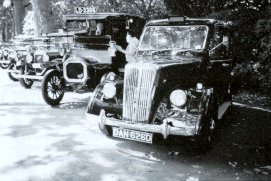The Call Sign Connection to the
London Vintage Taxi Association
THE LONDON VINTAGE TAXI ASSOCIATION’S 21ST BIRTHDAY CELEBRATIONS
The London Vintage Taxi Association was founded in 1978 for the owners and enthusiasts
of the London-type taxicab. To celebrate its ‘coming of age’, there will be a
weekend event for members in the New Forest including,, on Saturday 5th June, a
public display at the National Motor Museum at Beaulieu. This will include a competition
to find the Vintage Taxi Driver of the Year.
Unlike most enthusiast clubs, the London Vintage Taxi Association does not
cater for one particular model, or even one particular make. Our relatively small
world-wide membership cares for retired London-type taxicabs from 1907 right up to the
present day; from Austin to Winchester, via long-gone companies such as Beardmore,
Nuffield and Unic.
To find out more about the LVTA, contact the Membership Secretary, 51
Ferndale Crescent, Cowley, Uxbridge, Middlesex UB8 2AY, or come to see us at Beaulieu on 5th
June.
You’ll have a great day out…
Keith White (A16)

THE GUIDE TO VINTAGE BRITISH TAXIS
With thanks to Merle Peirce of the International section of the LVTA, Call Sign continues the first-ever A-Z guide to every British vehicle that has ever been used as a taxi or designed for use as a taxi…
Austin
Seven
Exhibited at the 1925 Commercial Motor Show, the single seat Austin Seven
taxi was based on the AC Tourer body and 12 examples were produced for trials in London.
Passenger acceptance was poor and all twelve were recalled to Longbridge for conversion to
stock tourers.
High Lot (TT)
Introduced in 1930, the High Lot chassis was based on the Heavy 12 saloon
car, with custom bodies by Jones, Ricketts, Strachan and Vincent, etc.
Low Loader
Designed for passenger comfort, the Low Loader was introduced in 1935 with
a reduced floor height and remained in production until the war caused a halt to taxi
production in 1939.
FX1 and FX2
These two experimental prototypes date from 1945-1946 and represent
intermediate designs between the streamlined pre-war Austin’s and the FX3.
FX3
The FX-3 was offered with its own coachwork from Carbodies and was
available from 1948-1958. The Prototypes were JXN841 and JXN842. Experimental diesel units
appeared in 1955-56 with BMC and Perkins power units, and a series of automatic test
vehicles in 1957-58, only one of which one is known to survive.
The ubiquitous FX4 appeared in 1959 with the prototype being VLW 431 and remained, albeit heavily modified, in production until 1997. With the Mini, it stands as one of the longest lived British motor designs.
FX4G
The gasoline-powered version used a sleeved 2178 c.c. version of the
Austin-Healey 100-4 engine.
FX4D
The diesel version was powered by a BMC K-series (2.2 litre) or, from 1969,
a British Leyland 25V (2.52 litre) engine.
FX4R
This later version (1982-1985) was fitted with the 2.25litre Land Rover
diesel and 5 speed gearbox.
FX4S
This 1985-1987 variant was fitted with the 2.5 litre Rover diesel.
FX4S+
Available during 1987-1988, the FX4S+ was fitted with more driver amenities
and is distinguished by its beige interior.
FX5
Carbodies and British Leyland developed this prototype during 1970-1979,
but production was abandoned due to excessive tooling costs.
FL1
The hire-car version of the FX3 lacked the ‘For Hire’ sign and
had a higher speed crown-wheel assembly.
FL-2
The hire car version of the FX4 also lacked the ‘For Hire’ sign
and came with a higher speed crown-wheel assembly.
CR6 (Carbodies Rover 6)
The experimental prototype, CRW 293Y, used Rover SD1 and Range Rover parts
and was planned for a 1984 introduction, but was never produced.
Specials
FX3 and FX4 chassis were available and used as the basis for newspaper
vans, hearses and flower cars amongst others. At least two FX3 shooting brakes were
constructed - one for The John O'Groats Public House; a special for Nubar Gulbankian and
during the 1980's, a single six-door FX4 limousine prototype was constructed.